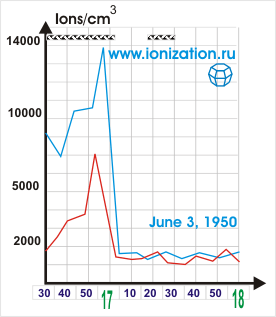On the 3rd of June 1950 there was one of the greatest thunderstorms that were recently observed in Uppsala. It began very quickly near the city and then abruptly stopped. The period of thunderstorm continued from 3.21PM till 5.35PM. The general quantity of precipitations was 32,3mm, the most effective precipitations were observed at 3.45PM. Thunderstorm moved from west to east. Thunderstorm could be divided into two general periods: during the 1st period the general action with direct strokes of lightning was observed in several parts of the city, 0,5 cm hails also took place there; during the 2nd period thunderstorm was partially heavier near the Institute, hail accompanied a shower.
The results of light air ions concentration measurements during the second period are shown on a picture. Values of ions density are significant, partially during the hail, which was hatched on a picture. The decrease of negative ions density was more than the decrease of positive ones, the increase of ions density was indicated during heavy showers: the decrease was very quick. During the thunderstorm air temperature was consonant.

Conclusions of measurement results.
Summing up all the results of ions density measurements near the ground surface during thunderstorm conditions we can outline the following facts:
- the increase of concentration of light ions of both polarities.
- the increase of ions density was usual during heavy showers, so heavy showers always accompanied the increase of light ions density, but the increase of ions density of both polarities did not always accompany heavy showers.
- the increase of negative light ions concentration was more than the increase of positive ones. But characteristic properties of light ions density fluctuations during thunderstorm was the increase of both polarities, while at normal rain the density of negative ions could increase because of the Lenard effect.
- the increase of ions density appeared in several minutes and could stay at that level during some minutes, but it also could quickly decrease.
- besides the decrease of light ions density there could be the same effect with positive heavy ions.
- the characteristic form of light ions density fluctuations during the residual thunderstorm: the density of ions decreased in 5-10 minutes up to the comparatively small value, during the following 5-10 minutes achieving the normal value of the present day; when the density of positive ions comparatively small and lower than the density of negative ones, but then it increased up to the normal value in 15-25 minutes.
The article is composed and developed by A. Tuktagulov (www.ionization.ru) from the materials of Uppsala University
FULL OR PARTIAL CITING OF THE ARTICLE IS FORBIDDEN




